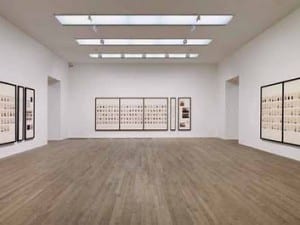Fashion designer Peter Jensen has made the innovative decision to debut his Spring/Summer’13 collection for the first time in Britain at The Hepworth Wakefield. Under the same roof as many of Barbara Hepworth’s works, Jensen uses the artist as a starting point for his newest designs. With contemporary exhibitions from Linder Sterling, Alice Channer and Jessica Jackson Hutchins also celebrating Hepworth’s legacy at The Hepworth this spring, Jensen’s creations offer an alternate response to Hepworth’s body of work, representing her far-reaching influence. On 27 March, Jensen showcases a new angle of fashion and Barbara Hepworth’s vast archive.
A: What was it that made you want to preview your S/S13 collection in a gallery? And why specifically the Hepworth?
PJ: The collection is inspired by Barbara Hepworth and her work, and the chance of seeing models wearing the clothes in such an amazing space, amongst Hepworth’s work, was irresistible. I’m always interested in showing my work in different places, in different contexts and formats, it keeps it interesting for me and hopefully for other people. It’s nice to show the work to new audiences – Wakefield might not be a major fashion capital, but that’s what makes in interesting for me.
A: You have a wide collection of female “muses”, Sissy Spacek, Cindy Sherman, Helena Rubinstein, Tonya Harding, Jodie Foster, do you design in response to them or as if dressing them?
PJ: Each one has been very different. For instance, Sissy was directly inspired by a lot of her character’s costumes, though the appeal for me was also the actress herself. Cindy was inspired by Sherman’s early work, like the film stills and portraits of people on the bus, and it was more process driven; to start that collection I asked different friends to style looks from clothes I had selected and used the resulting photographs to design from. Helena was largely inspired by a biography of Rubinstein and Elizabeth Arden (War Paint), and it was very much an appeal of personality. Tonya was presented on ice-skaters and that informed a lot of the design decisions; Jodie was much more about easy pieces, and tomboy dressing. They’re all women I am fascinated by in one way or another, but they appeal varies.
A: How are Barbara Hepworth’s works translated into your designs?
PJ: Part of the initial attraction was Barbara herself, their are so many great images of her, but the work was more of an influence on the design. For me this collection was quite restrained and minimal, it was about quite simple forms that feel well balanced, quieter colours. And holes of course.
A: How do you approach a new collection?
PJ: I don’t have a set format. Sometimes I have an idea for the type of clothes I want to make and then look for inspiration, other times the muse comes first with no real idea of how it will develop. Sometimes it’s a progression of ideas in the previous collection, sometimes it’s a reaction against them.
A: Are there any pieces from this collection that you are particularly fond of?
PJ: I like the whole collection. I very much like the dresses with the cut-outs, and perhaps they have the most obvious relation to Hepworth’s work. I think there are some good coats, a black lace mac and a coat panelled in different colours and prints, in particular. The hats are also very fun. Mostly I think it’s a very easy, wearable collection.
A: Your collection is also going to be shown amongst work by Linder Sterling, Alice Channer and Jessica Jackson Hutchins- how do you feel about the works by these artists?
PJ: It really is an honour to be shown amongst their works, I don’t think of what I do as art at all, but it’s often designed in some relation to art. The artist whose work I know best is Linder, first from her music and album art; I’m a fan. Perhaps it has the most obvious relationship with fashion – although perhaps they all do actually. I saw Alice Channer’s recent show at the South London Gallery, I liked it very much. Jessica’s work I know the least, but I’m excited to see more. Those ideas of appropriation of everyday objects, and of the amateur and naive, are things I’m also interested in;
A: Generally, how do you feel fashion and art sit together? Indistinguishable or very different
PJ: I feel they are very different, I don’t see fashion as art. Of course also have to consider the commercial but it’s a different relationship; in fashion a simple dress that someone loves wearing is totally successful, even if it communicates no ideas. I’m interested in trying to tell some kind of story and create different moods through the presentation but it can be very light. In general I think there is a relationship between the two, but they are definitely distinguishable.
A: What inspires you everyday?
PJ: I think everything I see, from TV and films, to art, to people in the street, to something I read in the newspaper. It’s sort of hard to pin down. I’m attracted to people and personalities, maybe that’s the main connection.
Artwalk: Peter Jensen, 27 March, 5-7 pm, free, The Hepworth Wakefield, Gallery Walk, Wakefield, West Yorkshire, WF1 5AW.
Credits
All images courtesy of Peter Jensen and The Hepworth Wakefield, taken from Peter Jensen Spring/Summer 2013.





